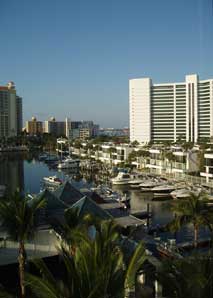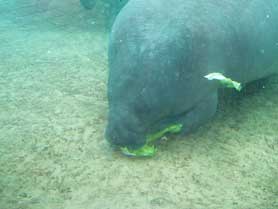You are here: Home › Stressors › Extreme Events › Harmful Algal Blooms › Feature Stories › State of the Research on Red Tide in the Gulf of Mexico Forum Seeks Public Input
State of the Research on Red Tide in the Gulf of Mexico Forum Seeks Public Input
July 20, 2006
Sarasota, Florida

Nationally and internationally known red tide experts will meet with the public to discuss the state of current scientific understanding on Florida red tide and respond to concerns during a moderated forum. The public forum will be held at Mote Marine Laboratory in Sarasota, Florida, as well as at Florida Gulf Coast University in Fort Myers, Florida, on Thursday, July 20, 2006 from 6-8pm (EST). The National Oceanic and Atmospheric Administration (NOAA), working in conjunction with Mote Marine Laboratory and the Florida Fish and Wildlife Conservation Commission's Fish and Wildlife Research Institute (FWRI), is sponsoring both the scientific meeting and the public forum.
A key element of this event is a survey hosted by Mote Marine Laboratory that will be disseminated prior to the forum. The survey is designed to allow residents and visitors to have a voice in the direction of future red tide research efforts. Interested members of the public may fill out the survey online at www.mote.org/redtideforum.
By sharing opinions and concerns, the public will play an integral role in helping scientists to identify red tide research areas that need further exploration. Researchers and managers will incorporate public input into discussions at a scientific meeting that will precede the forum. A panel of scientists will then meet with the public to report their findings and respond to additional concerns during a moderated forum.
Because of space limitations, public forum participants must register for a seat by calling 941-388-4441, ext. 473. They should indicate whether they want to attend the event at Mote in Sarasota or at Florida Gulf Coast University in south Fort Myers.
NOAA has been supporting research to understand how, when, and why blooms occur through its Monitoring and Event Response for Harmful Algal Blooms (MERHAB) program, and by its involvement with other agency partners in the Ecology and Oceanography of Harmful Algal Blooms (ECOHAB) program, including the Environmental Protection Agency, Office of Naval Research, and National Aeronautics & Space Administration. The agency has also been working to develop better methods of detecting and predicting blooms, and finding ways to reduce or prevent impacts on humans, coastal economies, and ecosystems. Considerable progress has been made, but a number of outstanding questions remain.
Florida red tides happen when a naturally occurring single-celled microscopic organism called Karenia brevis — which is always present in the Gulf of Mexico — undergoes a population explosion. Florida red tides occur nearly annually on Floridaís west coast and occur in other areas of the Gulf of Mexico as well. Karenia brevis produces neurotoxins that can kill marine mammals, fish and other marine creatures, and blooms have been shown to affect humans with chronic respiratory problems such as asthma. Because of these impacts, blooms may also have major impacts on coastal economies.

In January, 2005, an unusually early and large bloom of K. brevis developed on the West Florida Shelf, leading to mass fish kills and reports of human respiratory irritation. High mortalities of manatees and dolphins in the spring and summer, accompanied by the deaths of marine turtles, birds, and fish, resulted in the first-ever declaration of a multi-species Unusual Marine Mammal Mortality Event. As the bloom developed, mortalities of some fish and bottom-dwelling organisms resulted from contact with K. brevis toxins. The decaying animals and K. brevis cells caused depletion of bottom water oxygen, which led to mass mortalities of diverse organisms across stretches of sea-bottom including coral reef environments. Data collected by Center for Sponsored Coastal Ocean Research (CSCOR)-MERHAB funded researchers and the State of Florida, with assistance from local divers, indicated that the impacts were widespread, affecting an area of over 2,162 square miles west of central Florida. The last time widespread bottom water anoxia occurred in the same area was 1972, according to FWRI.
For more information on the workshop or to reserve a seat, please visit http://www.mote.org/redtideforum.
Related Links
- CSCOR Sponsored Research Advances Efforts to Understand Recent Florida Red Tide Events
- BreveBusters Provide Automated, In-Water Detection of Florida Red Tide Conditions
- New Monitoring Capability to Improve Forecasts of Florida Harmful Algal Blooms
- Click Here For More Information on Harmful Algal Blooms (or HABs)

